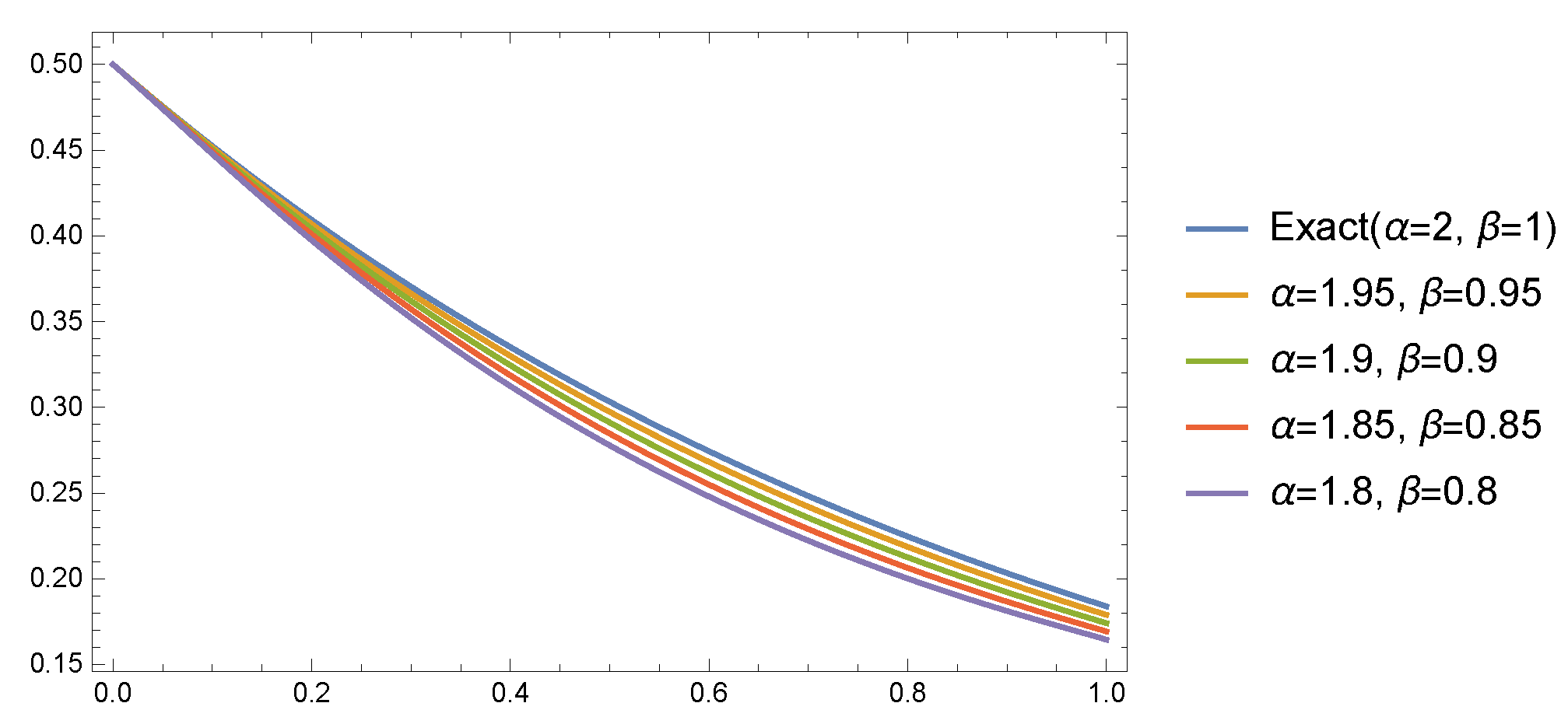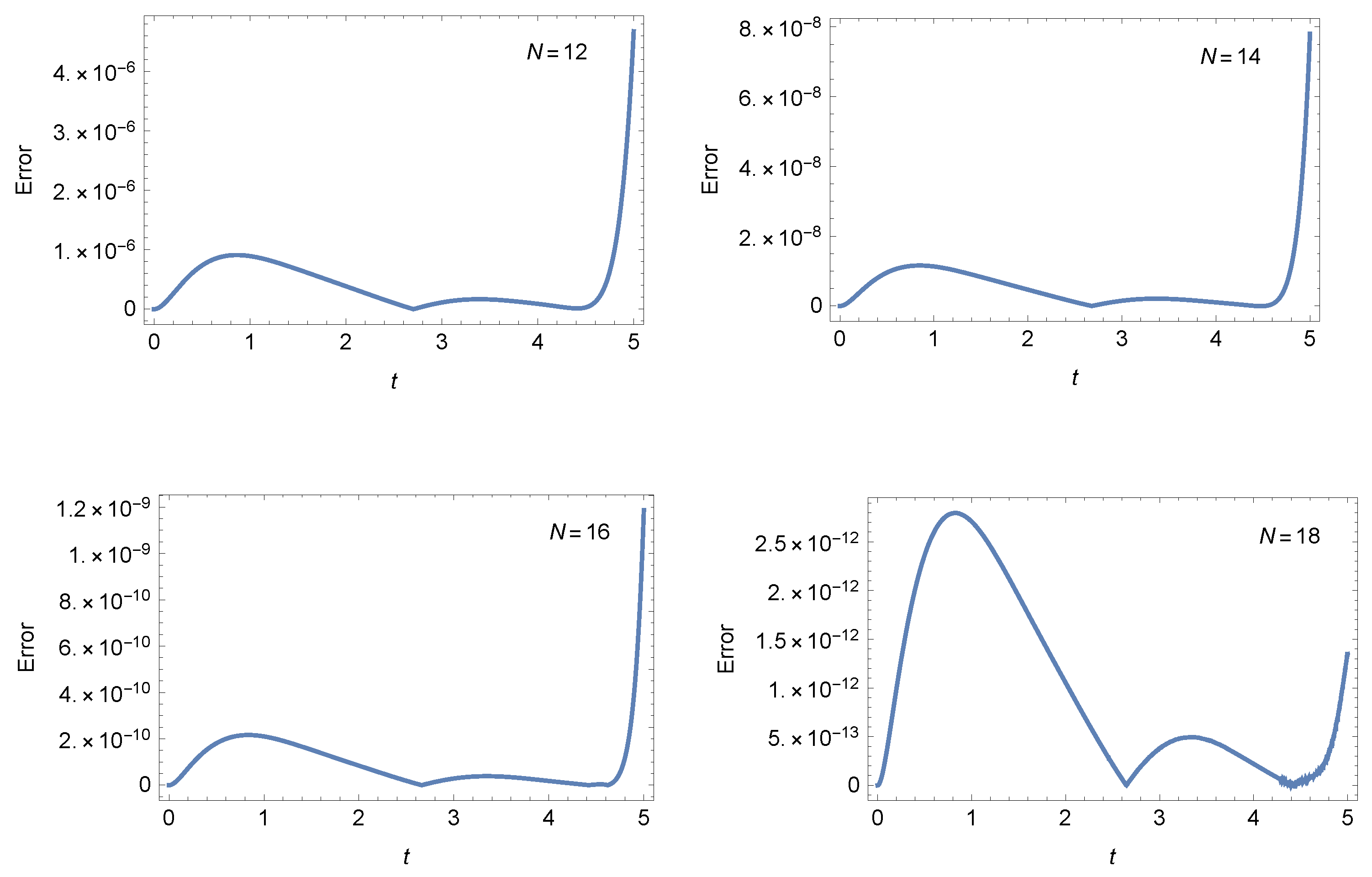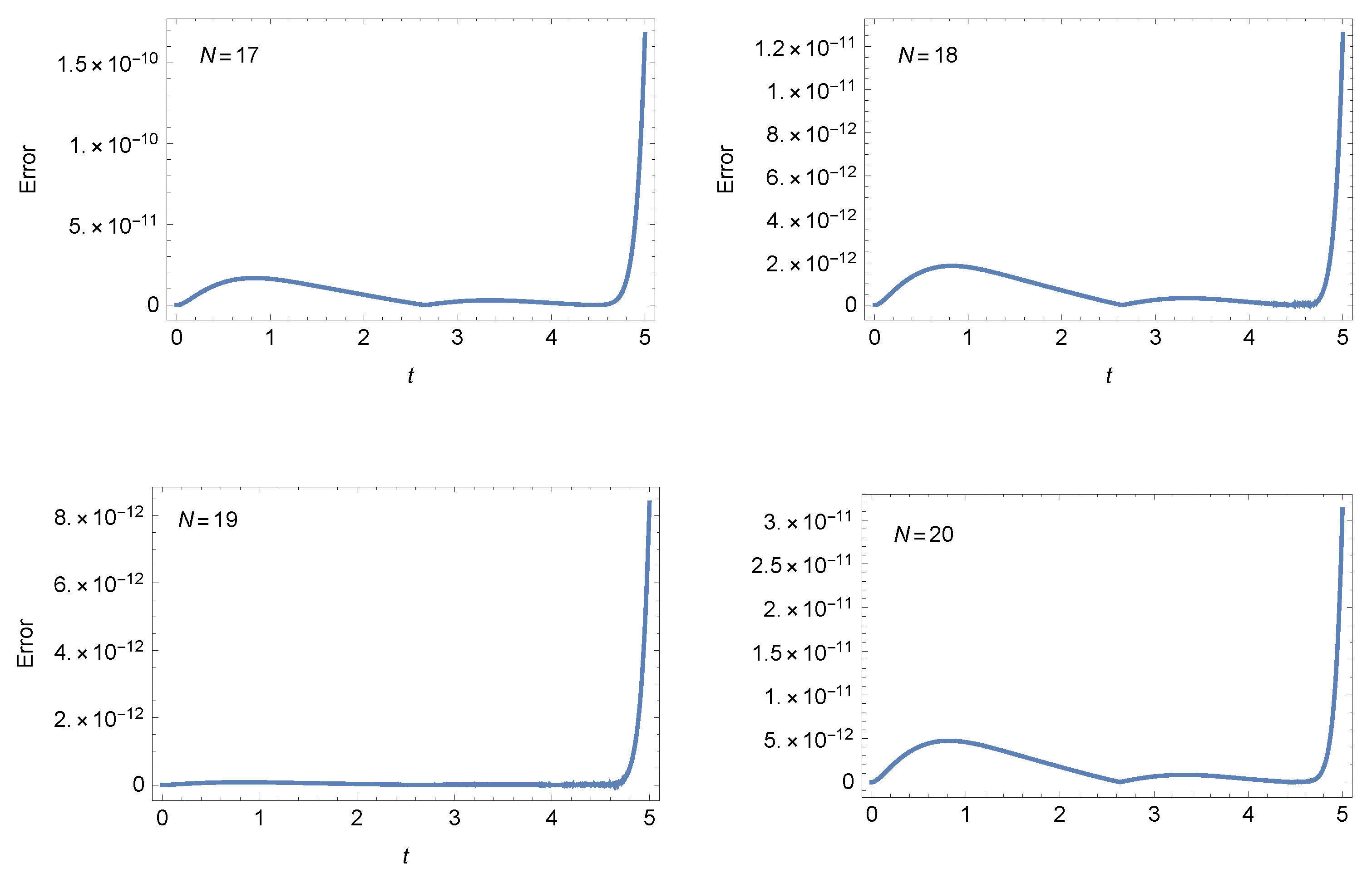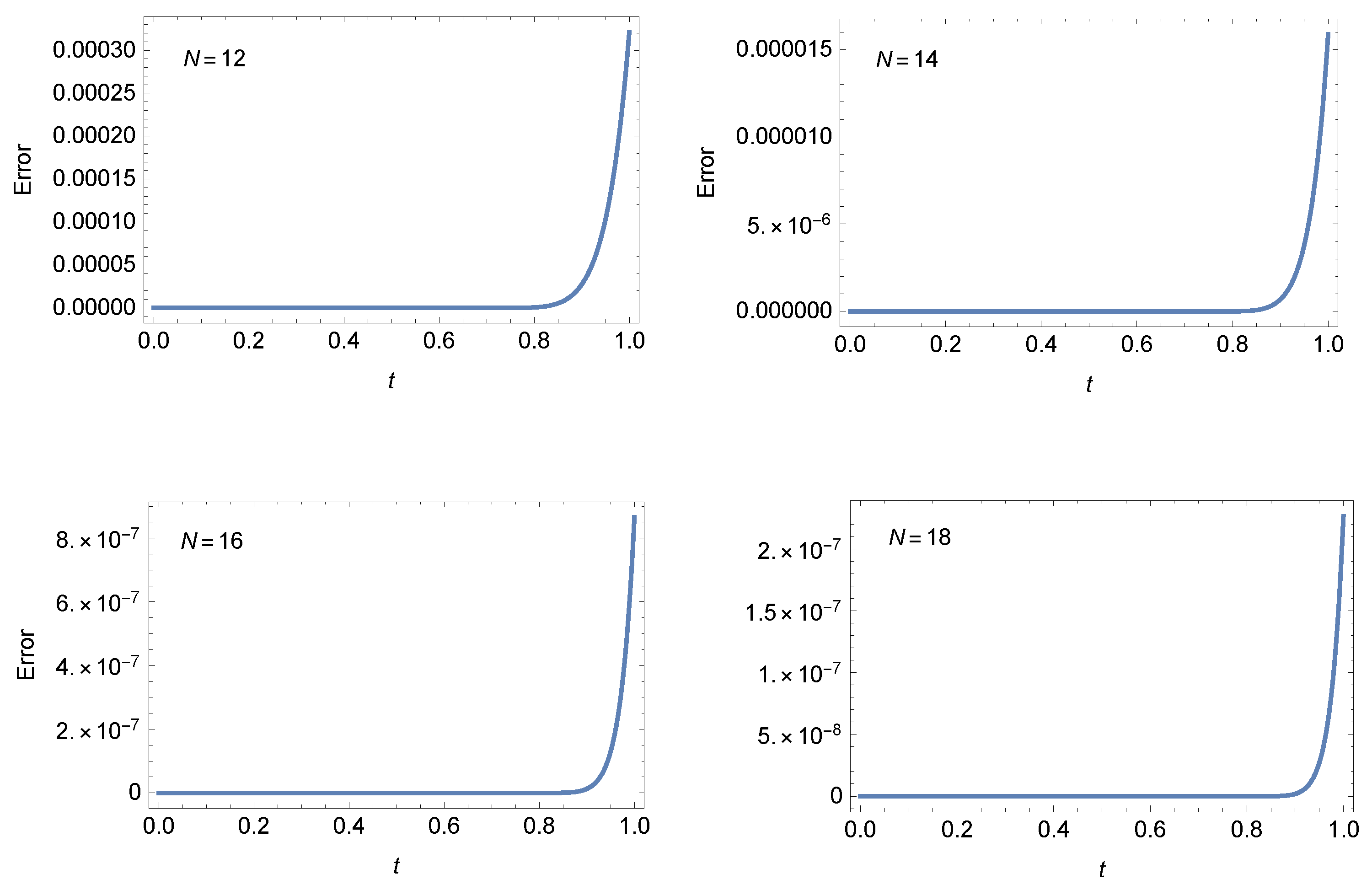Numerical Solutions for Nonlinear Ordinary and Fractional Duffing Equations Using Combined Fibonacci–Lucas Polynomials
Abstract
1. Introduction
- Introducing a new type of generalized Fibonacci and Lucas polynomials.
- Establishing some theoretical results concerning these polynomials that will be the backbone of our numerical results.
- Designing a numerical algorithm for treating the nonlinear second-order Duffing equation.
- Designing a numerical algorithm for treating the nonlinear fractional Duffing equation.
- Discussing the error analysis of the proposed method.
- Testing our algorithms numerically by presenting some numerical examples with some comparisons.
- By choosing combined Fibonacci-Lucas polynomials as basis functions, a few retained modes produce highly accurate approximations.
- The approach requires fewer computations to achieve the desired precision.
- We can obtain several approximate solutions based on the presence of two free parameters, a and b.
- Our technique can treat both linear and non-linear equations.
2. Introducing a Unified Sequence of Fibonacci and Lucas Polynomials
2.1. Fibonacci and Lucas Polynomial Sequences
2.2. Derivatives and Operational Matrices of the Fibonacci–Lucas Polynomials
3. A Matrix Collocation Approach for the Nonlinear Second-Order Duffing Equation
- Now, let us define the following space function:
4. A Matrix Collocation Approach for the Nonlinear Fractional-Order Duffing Equation
4.1. The Operational Matrix of Fractional Derivatives for
4.2. Collocation Algorithm for the NFDE
5. Error Bound
6. Illustrative Examples
- Case 1: For and , Table 1 presents the AEs at different values of at when . Furthermore, Figure 1 shows the AEs at at different values of N when . Figure 2 shows that the approximate solutions have smaller variations for values of α and β near the values and when Table 2 presents the absolute errors (AEs) at different values of at when and .
- Case 1: For , Table 4 and Table 5 present the AEs at different values of at, respectively, and when . Table 6 presents the AEs at different values of at when . Figure 4 shows that the approximate solutions have smaller variations for values of α and β near the values and when Table 7 presents the absolute errors (AEs) at different values of at when and .
7. Concluding Remarks
Author Contributions
Funding
Data Availability Statement
Acknowledgments
Conflicts of Interest
References
- Boyd, J.P. Chebyshev and Fourier Spectral Methods; Courier Corporation: North Chelmsford, MA, USA, 2001. [Google Scholar]
- Hesthaven, J.; Gottlieb, S.; Gottlieb, D. Spectral Methods for Time-Dependent Problems; Cambridge University Press: Cambridge, UK, 2007; Volume 21. [Google Scholar]
- Trefethen, L.N. Spectral Methods in MATLAB; SIAM: Philadelphia, PA, USA, 2000; Volume 10. [Google Scholar]
- Koshy, T. Fibonacci and Lucas Numbers with Applications; John Wiley & Sons: Hoboken, NJ, USA, 2019. [Google Scholar]
- Ozkan, E.; Altun, I. Generalized Lucas polynomials and relationships between the Fibonacci polynomials and Lucas polynomials. Comm. Algebra 2019, 47, 4020–4030. [Google Scholar] [CrossRef]
- Özkan, E.; Taştan, M. On Gauss Fibonacci polynomials, on Gauss Lucas polynomials and their applications. Comm. Algebra 2020, 48, 952–960. [Google Scholar] [CrossRef]
- Du, T.; Wu, Z. Some identities involving the bi-periodic Fibonacci and Lucas polynomials. AIMS Math. 2023, 8, 5838–5846. [Google Scholar] [CrossRef]
- Haq, S.; Ali, I. Approximate solution of two-dimensional Sobolev equation using a mixed Lucas and Fibonacci polynomials. Eng. Comput. 2022, 38, 2059–2068. [Google Scholar] [CrossRef]
- Mohamed, A.S. Fibonacci collocation pseudo-spectral method of variable-order space-fractional diffusion equations with error analysis. AIMS Math. 2022, 7, 14323–14337. [Google Scholar] [CrossRef]
- Manohara, G.; Kumbinarasaiah, S. An Innovative Fibonacci Wavelet Collocation Method for the Numerical Approximation of Emden-Fowler Equations. Appl. Numer. Math. 2024, 201, 347–369. [Google Scholar]
- Abd-Elhameed, W.M.; Al-Harbi, A.K.; Alqubori, O.M.; Alharbi, M.H.; Atta, A.G. Collocation method for the time-fractional generalized Kawahara equation using a certain Lucas polynomial sequence. Axioms 2025, 14, 114. [Google Scholar] [CrossRef]
- Abd-Elhameed, W.M. Novel expressions for the derivatives of sixth-kind Chebyshev polynomials: Spectral solution of the non-linear one-dimensional Burgers’ equation. Fractal Fract. 2021, 5, 74. [Google Scholar] [CrossRef]
- Youssri, Y.H.; Abd-Elhameed, W.M.; Abdelhakem, M. A robust spectral treatment of a class of initial value problems using modified Chebyshev polynomials. Math. Methods Appl. Sci. 2021, 44, 9224–9236. [Google Scholar] [CrossRef]
- Ahmed, H.M. A new first finite class of classical orthogonal polynomials operational matrices: An application for solving fractional differential equations. Contemp. Math. 2023, 4, 974–994. [Google Scholar] [CrossRef]
- Tohidi, E.; Bhrawy, A.H.; Erfani, K. A collocation method based on Bernoulli operational matrix for numerical solution of generalized pantograph equation. Appl. Math. Model. 2013, 37, 4283–4294. [Google Scholar] [CrossRef]
- Abd-Elhameed, W.M.; Alsuyuti, M.M. New spectral algorithm for fractional delay pantograph equation using certain orthogonal generalized Chebyshev polynomials. Commun. Nonlinear Sci. Numer. Simul. 2025, 141, 108479. [Google Scholar] [CrossRef]
- Ahmed, H.M. New generalized Jacobi Galerkin operational matrices of derivatives: An algorithm for solving multi-term variable-order time-fractional diffusion-wave equations. Fractal Fract. 2024, 8, 68. [Google Scholar] [CrossRef]
- Enns, R.M. Nonlinear Phenomena in Physics and Biology; Springer Science & Business Media: New York, NY, USA, 2012; Volume 75. [Google Scholar]
- Hilborn, R.C. Chaos and Nonlinear Dynamics: An Introduction for Scientists and Engineers; Oxford University Press: Oxford, UK, 2000. [Google Scholar]
- Magin, R. Fractional calculus in bioengineering, part 1. Crit. Rev. Biomed. Eng. 2004, 32, 1–104. [Google Scholar] [CrossRef]
- Abd-Elhameed, W.M.; Ahmed, H.M. Spectral solutions for the time-fractional heat differential equation through a novel unified sequence of Chebyshev polynomials. AIMS Math. 2024, 9, 2137–2166. [Google Scholar] [CrossRef]
- Wang, F.; Hou, E.; Salama, S.A.; Khater, M.M.A. Numerical investigation of the nonlinear fractional Ostrovsky equation. Fractals 2022, 30, 2240142. [Google Scholar] [CrossRef]
- Amin, A.Z.; Abdelkawy, M.A.; Solouma, E.; Al-Dayel, I. A spectral collocation method for solving the non-linear distributed-order fractional Bagley–Torvik differential equation. Fractal Fract. 2023, 7, 780. [Google Scholar] [CrossRef]
- Heydari, M.H.; Razzaghi, M.; Baleanu, D. A numerical method based on the piecewise Jacobi functions for distributed-order fractional Schrödinger equation. Commun. Nonlinear Sci. Numer. Simul. 2023, 116, 106873. [Google Scholar] [CrossRef]
- Kovacic, I.; Brennan, M.J. The Duffing Equation: Nonlinear Oscillators and Their Behaviour; John Wiley & Sons: Hoboken, NJ, USA, 2011. [Google Scholar]
- Alvarez-Ramirez, J.; Espinosa-Paredes, G.; Puebla, H. Chaos control using small-amplitude damping signals. Phys. Lett. A 2003, 316, 196–205. [Google Scholar] [CrossRef]
- Aghdam, M.M.; Fallah, A. Analytical Solutions for Generalized Duffing Equation. In Nonlinear Approaches in Engineering Applications: Advanced Analysis of Vehicle Related Technologies; Springer: Cham, Switzerland, 2016; pp. 263–278. [Google Scholar]
- El-Sayed, A.A. Pell-Lucas polynomials for numerical treatment of the nonlinear fractional-order Duffing equation. Demonstr. Math. 2023, 56, 20220220. [Google Scholar] [CrossRef]
- Wang, Y.R.; Chen, G.W. Predicting multiple numerical solutions to the Duffing equation using machine learning. Appl. Sci. 2023, 13, 10359. [Google Scholar] [CrossRef]
- Kamiński, M.; Corigliano, A. Numerical solution of the Duffing equation with random coefficients. Meccanica 2015, 50, 1841–1853. [Google Scholar] [CrossRef]
- Elías-Zúñiga, A. A general solution of the Duffing equation. Nonlinear Dynam. 2006, 45, 227–235. [Google Scholar] [CrossRef]
- Abdulganiy, R.I.; Wen, S.; Feng, Y.; Zhang, W.; Tang, N. Adapted block hybrid method for the numerical solution of Duffing equations and related problems. AIMS Math. 2021, 6, 14013–14034. [Google Scholar] [CrossRef]
- Geng, F. Numerical solutions of Duffing equations involving both integral and non-integral forcing terms. Comput. Math. Appl. 2011, 61, 1935–1938. [Google Scholar] [CrossRef]
- Tabatabaei, K.; Gunerhan, E. Numerical solution of Duffing equation by the differential transform method. Appl. Math. Inf. Sci. Lett. 2014, 2, 1–6. [Google Scholar]
- Salas, A.H.; Castillo, J.E. Exact solutions to cubic Duffing equation for a nonlinear electrical circuit. Visión Electrónica 2014, 8, 46–53. [Google Scholar]
- Singh, H.; Srivastava, H.M. Numerical investigation of the fractional-order Liénard and Duffing equations arising in oscillating circuit theory. Front. Phys. 2020, 8, 120. [Google Scholar] [CrossRef]
- Kim, V.A.; Parovik, R.I.; Rakhmonov, Z.R. Implicit finite-difference scheme for a Duffing oscillator with a derivative of variable fractional order of the Riemann-Liouville Type. Mathematics 2023, 11, 558. [Google Scholar] [CrossRef]
- Kim, V.A.; Parovik, R.I. Some aspects of the numerical analysis of a fractional duffing oscillator with a fractional variable order derivative of the Riemann-Liouville type. AIP Conf. Proc. 2022, 2467, 060014. [Google Scholar]
- Canuto, C.; Hussaini, M.Y.; Quarteroni, A.; Zang, T.A. Spectral Methods in Fluid Dynamics; Springer: Berlin/Heidelberg, Germany, 1988. [Google Scholar]
- Alsuyuti, M.M.; Doha, E.H.; Ezz-Eldien, S.S. Galerkin operational approach for multi-dimensions fractional differential equations. Commun. Nonlinear Sci. Numer. Simul. 2022, 114, 106608. [Google Scholar] [CrossRef]
- Atta, A.G.; Abd-Elhameed, W.M.; Moatimid, G.M.; Youssri, Y.H. Shifted fifth-kind Chebyshev Galerkin treatment for linear hyperbolic first-order partial differential equations. Appl. Numer. Math. 2021, 167, 237–256. [Google Scholar] [CrossRef]
- Hafez, R.M.; Youssri, Y.H. Fully Jacobi–Galerkin algorithm for two-dimensional time-dependent PDEs arising in physics. Int. J. Mod. Phys. C 2024, 35, 2450034. [Google Scholar] [CrossRef]
- Atta, A.G.; Abd-Elhameed, W.M.; Moatimid, G.M.; Youssri, Y.H. Modal shifted fifth-kind Chebyshev tau integral approach for solving heat conduction equation. Fractal Fract. 2022, 6, 619. [Google Scholar] [CrossRef]
- El-Sayed, A.A.; Boulaaras, S.; Sweilam, N.H. Numerical solution of the fractional-order logistic equation via the first-kind Dickson polynomials and spectral tau method. Math. Meth. Appl. Sci. 2023, 46, 8004–8017. [Google Scholar] [CrossRef]
- Tu, H.; Wang, Y.; Yang, C.; Liu, W.; Wang, X. A Chebyshev–Tau spectral method for coupled modes of underwater sound propagation in range-dependent ocean environments. Phys. Fluids 2023, 35, 037113. [Google Scholar] [CrossRef]
- Mostafa, D.; Zaky, M.A.; Hafez, R.M.; Hendy, A.S.; Abdelkawy, M.A.; Aldraiweesh, A.A. Tanh Jacobi spectral collocation method for the numerical simulation of nonlinear Schrödinger equations on unbounded domain. Math. Meth. Appl. Sci. 2023, 46, 656–674. [Google Scholar] [CrossRef]
- Weera, W.; Kumar, R.S.V.; Sowmya, G.; Khan, U.; Prasannakumara, B.C.; Mahmoud, E.E.; Yahia, I.S. Convective-radiative thermal investigation of a porous dovetail fin using spectral collocation method. Ain Shams Eng. J. 2023, 14, 101811. [Google Scholar] [CrossRef]
- Atta, A.G. Two spectral Gegenbauer methods for solving linear and nonlinear time fractional Cable problems. Int. J. Mod. Phys. C 2023, 35, 2450070. [Google Scholar] [CrossRef]
- Abd-Elhameed, W.M.; Alqubori, O.M.; Atta, A.G. A collocation procedure for treating the time-fractional FitzHugh–Nagumo differential equation using shifted Lucas polynomials. Mathematics 2024, 12, 3672. [Google Scholar] [CrossRef]
- Abd-Elhameed, W.M.; Alqubori, O.M.; Atta, A.G. A collocation procedure for the numerical treatment of FitzHugh–Nagumo equation using a kind of Chebyshev polynomials. AIMS Math. 2025, 10, 1201–1223. [Google Scholar] [CrossRef]
- Lyapin, A.P.; Akhtamova, S.S. Recurrence relations for the sections of the generating series of the solution to the multidimensional difference equation. Vestnik Udmurtskogo Universiteta Matematika Mekhanika Komp’yuternye Nauki 2021, 31, 414–423. [Google Scholar] [CrossRef]
- Pirmohabbati, P.; Sheikhani, A.H.R.; Najafi, H.S.; Ziabari, A.A. Numerical solution of full fractional Duffing equations with Cubic-Quintic-Heptic nonlinearities. AIMS Math. 2020, 5, 1621–1641. [Google Scholar] [CrossRef]
- Novozhenova, O.G. Life and science of Alexey Gerasimov, one of the pioneers of fractional calculus in Soviet Union. Fract. Calc. Appl. Anal. 2017, 20, 790–809. [Google Scholar] [CrossRef]
- Caputo, M.; Fabrizio, M. On the notion of fractional derivative and applications to the hysteresis phenomena. Meccanica 2017, 52, 3043–3052. [Google Scholar] [CrossRef]
- Caputo, M. Linear models of dissipation whose Q is almost frequency independent—II. Geophys. J. Int. 1967, 13, 529–539. [Google Scholar] [CrossRef]
- Gerasimov, A.N. Generalization of linear deformation laws and their application to internal friction problems. Appl. Math. Mech. 1948, 12, 529–539. [Google Scholar]
- Hafez, R.M.; Zaky, M.A.; Abdelkawy, M.A. Jacobi spectral Galerkin method for distributed-order fractional Rayleigh–Stokes problem for a generalized second grade fluid. Front. Phys. 2020, 7, 240. [Google Scholar] [CrossRef]








| t | ||||
|---|---|---|---|---|
| 0.1 | 1.77636 × | 1.9984 × | 3.88578 × | 1.16573 × |
| 0.2 | 3.44169 × | 3.66374 × | 6.66134 × | 1.9984 × |
| 0.3 | 4.4964 × | 4.82947 × | 6.66134 × | 2.66454 × |
| 0.4 | 5.21805 × | 5.71765 × | 7.77156 × | 3.10862 × |
| 0.5 | 5.77316 × | 6.21725 × | 8.88178 × | 3.38618 × |
| 0.6 | 6.10623 × | 6.66134 × | 1.05471 × | 3.71925 × |
| 0.7 | 6.46705 × | 6.93889 × | 1.08247 × | 3.85803 × |
| 0.8 | 6.74461 × | 7.35523 × | 1.19349 × | 4.05231 × |
| 0.9 | 7.13318 × | 7.60503 × | 1.02696 × | 4.16334 × |
| t | |||
|---|---|---|---|
| 0.1 | 1.11022 × | 3.33067 × | 1.11022 × |
| 0.2 | 2.22045 × | 4.44089 × | 2.77556 × |
| 0.3 | 2.22045 × | 7.21645 × | 3.33067 × |
| 0.4 | 2.22045 × | 8.32667 × | 3.33067 × |
| 0.5 | 1.66533 × | 8.32667 × | 3.88578 × |
| 0.6 | 3.33067 × | 8.32667 × | 3.88578 × |
| 0.7 | 2.49805 × | 8.88178 × | 4.16334 × |
| 0.8 | 3.60822 × | 1.08247 × | 4.99649 × |
| 0.9 | 4.44089 × | 1.05471 × | 6.38378 × |
| t | Method in [52] | Our Method at |
|---|---|---|
| 0 | 2.9762 × | 0 |
| 1.008 | 1.0924 × | 9.86874 × |
| 2.016 | 3.9923 × | 5.27874 × |
| 3.012 | 1.4726 × | 2.30097 × |
| 4.008 | 5.4206 × | 9.63606 × |
| 5.004 | 1.9913 × | 3.97005 × |
| 6 | 7.3004 × | 1.61747 × |
| 7.008 | 2.6387 × | 6.45425 × |
| 8.004 | 9.6327 × | 2.57282 × |
| 9 | 3.5087 × | 1.08199 × |
| 10.008 | 1.2596 × | 1.90535 × |
| 11.004 | 4.5672 × | 2.68969 × |
| 11.988 | 1.6717 × | 3.06842 × |
| t | |||
|---|---|---|---|
| 0.1 | 1.05497 × | 3.47492 × | 6.66711 × |
| 0.2 | 3.72070 × | 1.34005 × | 2.61693 × |
| 0.3 | 6.50468 × | 2.82842 × | 5.70139 × |
| 0.4 | 6.93596 × | 4.56552 × | 9.67302 × |
| 0.5 | 1.58985 × | 6.20886 × | 1.41893 × |
| 0.6 | 1.38779 × | 7.32403 × | 1.88159 × |
| 0.7 | 4.46876 × | 7.38901 × | 2.30307 × |
| 0.8 | 9.68835 × | 5.79933 × | 2.62293 × |
| 0.9 | 1.77274 × | 7.87423 × | 2.77310 × |
| t | |||
|---|---|---|---|
| 0.1 | 1.08735 × | 3.14522 × | 1.70807 × |
| 0.2 | 2.99588 × | 1.01358 × | 5.05742 × |
| 0.3 | 4.43908 × | 1.80481 × | 8.12949 × |
| 0.4 | 5.10886 × | 2.49366 × | 9.98418 × |
| 0.5 | 5.65089 × | 2.98097 × | 1.06351 × |
| 0.6 | 7.63035 × | 3.25955 × | 1.10154 × |
| 0.7 | 1.34886 × | 3.40979 × | 1.29345 × |
| 0.8 | 2.64908 × | 3.59449 × | 1.90254 × |
| 0.9 | 5.06659 × | 4.05282 × | 3.26851 × |
| t | ||||
|---|---|---|---|---|
| 0.1 | 1.9984 × | 6.66134 × | 8.88178 × | 1.55431 × |
| 0.2 | 3.88578 × | 8.88178 × | 9.99201 × | 2.66454 × |
| 0.3 | 5.32907 × | 1.33227 × | 2.22045 × | 3.55271 × |
| 0.4 | 6.99441 × | 1.9984 × | 3.21965 × | 5.10703 × |
| 0.5 | 7.99361 × | 2.22045 × | 2.88658 × | 5.66214 × |
| 0.6 | 8.65974 × | 2.66454 × | 3.44169 × | 5.88418 × |
| 0.7 | 8.21565 × | 2.33147 × | 3.55271 × | 5.66214 × |
| 0.8 | 8.32667 × | 2.33147 × | 2.55351 × | 5.88418 × |
| 0.9 | 8.65974 × | 2.44249 × | 3.77476 × | 6.10623 × |
| t | |||
|---|---|---|---|
| 0.1 | 1.11022 × | 1.11022 × | 1.11022 × |
| 0.2 | 0 | 0 | 0 |
| 0.3 | 1.11022 × | 1.11022 × | 1.11022 × |
| 0.4 | 4.44089 × | 4.44089 × | 4.44089 × |
| 0.5 | 3.33067 × | 3.33067 × | 3.33067 × |
| 0.6 | 2.22045 × | 2.22045 × | 2.22045 × |
| 0.7 | 1.11022 × | 1.11022 × | 1.11022 × |
| 0.8 | 0 | 0 | 0 |
| 0.9 | 2.22045 × | 2.22045 × | 2.22045 × |
Disclaimer/Publisher’s Note: The statements, opinions and data contained in all publications are solely those of the individual author(s) and contributor(s) and not of MDPI and/or the editor(s). MDPI and/or the editor(s) disclaim responsibility for any injury to people or property resulting from any ideas, methods, instructions or products referred to in the content. |
© 2025 by the authors. Licensee MDPI, Basel, Switzerland. This article is an open access article distributed under the terms and conditions of the Creative Commons Attribution (CC BY) license (https://creativecommons.org/licenses/by/4.0/).
Share and Cite
Abd-Elhameed, W.M.; Alqubori, O.M.; Amin, A.K.; Atta, A.G. Numerical Solutions for Nonlinear Ordinary and Fractional Duffing Equations Using Combined Fibonacci–Lucas Polynomials. Axioms 2025, 14, 314. https://doi.org/10.3390/axioms14040314
Abd-Elhameed WM, Alqubori OM, Amin AK, Atta AG. Numerical Solutions for Nonlinear Ordinary and Fractional Duffing Equations Using Combined Fibonacci–Lucas Polynomials. Axioms. 2025; 14(4):314. https://doi.org/10.3390/axioms14040314
Chicago/Turabian StyleAbd-Elhameed, Waleed Mohamed, Omar Mazen Alqubori, Amr Kamel Amin, and Ahmed Gamal Atta. 2025. "Numerical Solutions for Nonlinear Ordinary and Fractional Duffing Equations Using Combined Fibonacci–Lucas Polynomials" Axioms 14, no. 4: 314. https://doi.org/10.3390/axioms14040314
APA StyleAbd-Elhameed, W. M., Alqubori, O. M., Amin, A. K., & Atta, A. G. (2025). Numerical Solutions for Nonlinear Ordinary and Fractional Duffing Equations Using Combined Fibonacci–Lucas Polynomials. Axioms, 14(4), 314. https://doi.org/10.3390/axioms14040314






